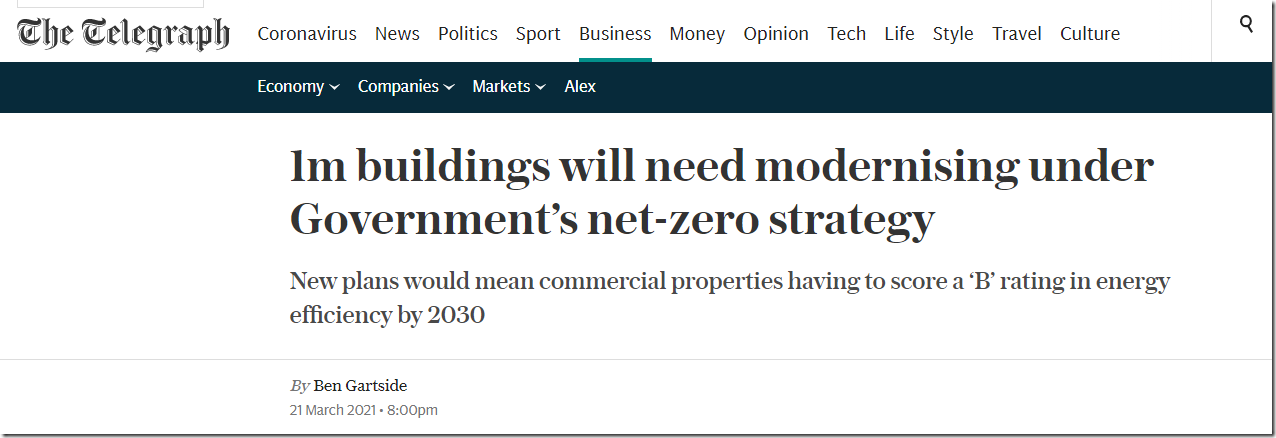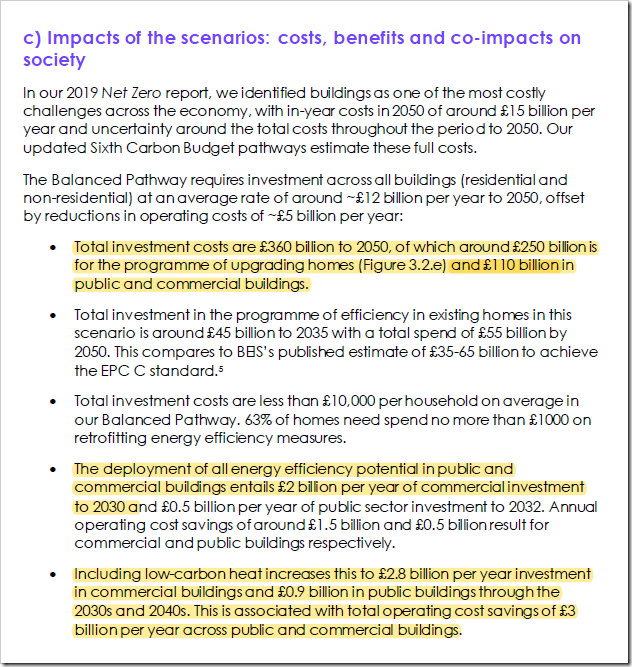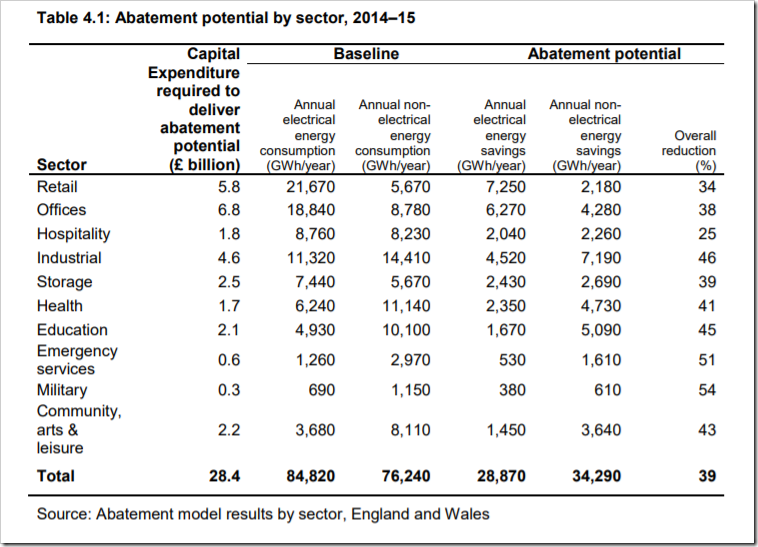New Energy Efficiency Targets Will Cost Businesses Dearly
By Paul Homewood
h/t Ian Magness
New plans will cost businesses tens of billions of pound:
One million commercial properties will need to be renovated in order to meet the Government’s new carbon targets, according to impact assessments.
New plans would mean commercial properties having to score a “B” rating in energy efficiency by 2030.
While key players in the property industry say they support the Government’s ambition to make the UK carbon net zero by 2050, they have complained about amount of time until the new rules become law and said officials must provide a clearer idea of regulations beyond 2030.
The Department of Business, Energy and Industrial Strategy is consulting the sector on the plans, which it says could affect up to a million buildings across the UK.
The British Property Federation has accused the Government’s strategy of being short-termist, saying that it does not factor in the long turn around times of commercial property projects.
Alex Green, associate director of the British Property Federation, said: “The Government’s commitment to a new stretching Minimum Energy Efficiency Standard up to 2030 will also act as an important signal to industry, but this is still too short-term in its approach for commercial property investors whose investment decisions today are based on forecasts that span the next several decades to come.
“The Government must provide a regulatory roadmap beyond 2030 to support property owners’ investment into our town and city centres.”
Nils Rage of Landsec said it will not be easy for many buildings to meet the 2030 target.
Richard Quartermaine of Hammerson welcomed the net-zero strategy, but said that the energy efficiency target would be a challenge.
Mr Quartermaine said: “We welcome these initial steps, however, we need all types of property to be focused on. This will be a challenge, however shifting the mindset and accountability on to operational energy consumption is essential if, as a sector, we want to move forward at pace to reach net zero.”
The Department of Business, Energy and Industrial Strategy had not responded to a request for comment at the time of publication.
According to the Committee on Climate Change, energy efficiency targets will cost the commercial sector £20bn by 2030. Much worse still, however, is the ongoing cost of installing expensive low carbon heating systems, which together with the energy efficiency measures will bring a bill of £110 billion by 2050 for commercial and public buildings, equivalent to £3.6 billion a year:
https://www.theccc.org.uk/publication/sixth-carbon-budget/
Obviously somebody thinks money grows on trees! The Telegraph claims businesses will save £1 billion a year in reduced energy costs (printed version), but this sounds extremely unlikely. BEIS savings are based on this 2016 study, suggesting that energy use could be cut by 39% (and effectively by half for heating):
Most businesses, certainly larger ones, in my experience are always keen to look at ways to reduce energy costs. Any schemes with a reasonable payback would be readily considered.
And as we know with domestic heating, if gas is to be replaced with electricity energy costs will balloon, dwarfing any savings.
Given that the BEIS have woefully underestimated the cost of insulating residential buildings, I suspect the cost will be much more than the £28bn quoted.
Put another way, £28bn for 1 million buildings comes to an average of £28000 each. It will cost £19000 to insulate an average house to EPC-C, so I cannot see £28000 going very far, even with smaller commercial buildings.
Comments are closed.



Presumably the Department of Business, Energy and Industrial Strategy will be the first to carry out the necessary measures on its own buildings, funded entirely within its own budget – absolutely no increase in taxes to cover it. Having done that, the Department can then handle the same procedure for all other government and local authority buildings, plus the replacement of all government vehicles immediately with electric ones. When that’s been done, the rest of us can see what the costs and benefits are!
Hard to see how any of that energy efficiency will lower the Earth’s temperature. Atmospheric CO2 will continue to rise until zero emissions is reached. NET-zero requires negative emissions.
If every building really did have a reverse fridge for heating I can imagine UHI might go -‘ve under some conditions. BBC weather will become “+1 or +2C in the countryside, -5C and a hard frost in town centers”!
MrGN – at those temperatures, the air-source heat-exchanger will not be running as a reverse fridge but as a resistance heater, so COP would be 1.0. The UHI would still be a few degrees higher than the countryside. That of course only really applies if there’s enough electricity generation to run that extra heating, and if the UK goes to the Saudi of wind-power it’s pretty likely that there will be periods in Winter when the grid is down and no such heating is available. In those circumstances, H+S would force employers to send their workers home to freeze instead, and the UHI effect would be reduced.
They ‘work’ down to significantly negative temperatures (just at reduced efficiency) that may require supplement. At -5C they will certainly still be sucking energy out of the air. But ATEOTD I was making a humerous point about local climate modification!
Apart from all these listed costs, what about the overhead costs to companies of having to staff complete new departments to handle this and the distraction of management from actually fulfilling their business’ purpose?
What it ignores is opportunity costs. If I can spend £100 billion making us either £10 billion a year more wealthy or £10 billion a year less wealthy, the cost of the second option is £20 billion a year, not £10 billion.
Politicians and the CCC claim its only £10 billion but that is a lie.
My company operates out of an old building that we refurbished 25 years ago, this is by no means unusual from my experiences. We have looked at building energy savings projects over the years, but apart from converting the heating boilers from oil to modern gas firing (over 20 years ago), none have had beneficial paybacks. In reality energy costs are a very small part of our outgoings.
There is no economical way that the building could be upgraded, it would be far cheaper to knock it down and buy a new building; unfortunately, the business cannot afford such luxuries without massive subsidies. The government and its advisors have little clue about real SMEs and their operation: they look at London and think that that represents the UK.
Lets upgrade all of London’s grade 1 and 2 listed buildings first. When Westminster abbey, St Pauls, British museums and galleries and westminster Hall have been upgraded to EPC 2 standard they can come back and talk to us.
Also the EPC standards are a joke and the assessing formulas a farce.
Interestingly, if you change from Gas to electric heating your rating will go down! So getting every building onto gas is the answer to getting better energy efficiency ratings.
I suspect that at some point fairly soon, the irresistible force will meet the immovable object, and this ingrained BEIS insanity will simply disappear like snow off a dyke.
It is sad that so many execs spout the nonsense that Net Zero is desirable, and don’t point out how it is not achievable.
The costs of operating office space will increase so expect the push for home working to be strong. And one company has already said not to expect any funds to cover your increased heating and electricity. My electricity use has gone up 15% over the last year due to home working. The counter is that I haven’t been paying for a season ticket . At least I didn’t use any extra heating and bought some warm fleecy shirts. Honestly though, during the freezing spell in February it was a bit tough and a prolonged cold spell might have seen my resolve crack.
The more I see of projected costs for this insane project the more I smell the stench of indulgences and the crooked market in ‘net-zero certificates.
It really boggles the mind how insane this unilateral UK ‘policy’ really is. So, as a direct result of this policy:
> By how much will global carbon emissions be reduced by 2100?
> By how much will global atmospheric CO2 concentrations be reduced by 2100?
> How many degrees of real ‘man made’ global warming will be abated by 2100?
> By how many degrees will global temperatures be reduced by 2100?
> How much will this cost in total?
> Can ministers confirm exactly when they absolutely lost the plot?
The UK is responsible for 1.1% of global CO2 emissions, The late David MacKay, Regius Professor of Engineering at Cambridge and former Chief Scientific Adviser to Dept of Energy and Climate Change calculated that if all the homes in the UK were powered exclusively by renewable energy it would only reduce UK emissions by 4%.
MacKay was talking about electricity, of course:
“The truth is that the amount of electrical power generated by the wonderful windmills that “could power all UK homes” is exactly the same as the amount that would be generated by the 10 nuclear power stations! “Powering all UK homes” accounts for just 4% of UK
emissions.”
If ‘powering homes’ included gas for cooking and heating then things are a bit different!
Replying to myself again, sorry.
https://www.thegwpf.com/eu-considers-labelling-natural-gas-as-sustainable-investment/
You have to laugh. Or something.
No, no, no. UK is responsible for 0.04% of global CO2 emissions.
‘The inmates have taken over the asylum’, used to be a cliche – not any longer.
And if the businesses and property owners decide not to waste their money on investments with a negative rate of return, how long will it be before powers are taken to force them to comply? Economic insanity but that won’t stop it happening.
This is so obviously marginal its absurd. The idea that spending vast sums to aggregate very small savings can work is utterly stupid. It never works because small errors in your estimates of the savings (which always go the wrong way) totally wipe out the forecast aggregated gains.
And with each individual saving being very small, its extremely easy to end with virtually no gains whatsoever, having spent vast amounts.